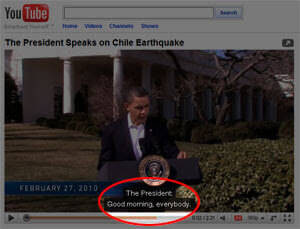Captions in Everyday Use
Yesterday Henny Swan asked a simple question on the Twitters:
I'm curious to know, who uses subtitles on web content (X device) who's not deaf or hard of hearing? For example I did when breastfeeding.
— Henny (@iheni) November 12, 2013
Adam Banks put together a Storify of the responses that show there are plenty of use cases for those not hard of hearing to get value from closed captioning.
In general, any context where either the audio track is loud enough that the viewer doesn’t want to disrupt those nearby, or the background noise is too much to hear the audio track clearly, is a case where captions have value for all users. Other cases that popped up include multi-tasking or working with a new language or just tough accents.
In short, closed captions have value for all users.
There is also no reason to panic about providing them, particularly if you use a video service that can do them for you. For example, back in 2010 YouTube committed to enabling auto-captioning for everyone, and Google has documents to help plus tutorials from others, such as this step-by-step or or this video.

Of course, as I was writing this post, Henny posted her own reference to the Twitter conversation: The weird and wonderful reasons why people use subtitles / captions
The Storify of responses I mentioned above is embedded here to spare you all the hassle of clicking the link and to bloat my page with unnecessary script blocks:
Update Dec-15-2017: Storify is going away, so I just embedded the tweets.
I'm curious to know, who uses subtitles on web content (X device) who's not deaf or hard of hearing? For example I did when breastfeeding.
— Henny (@iheni) November 12, 2013
@iheni I do, almost always. Sound is always off on my computer.
— Kimberly Blessing (@obiwankimberly) November 12, 2013
@iheni I do when I'm using my tablet while watching TV. (And if the videos don't have subtitles/captions, I don't watch.)
— Char James-Tanny (@CharJTF) November 12, 2013
@iheni Me. Supports sound qual of mob device, eliminates soundtrack lag, allows 2 devices 2b played in one room, and I have noisy children.
— Mike Gulliver (@mikegulliver) November 12, 2013
@iheni Always use sound off and subtitles at work. Saves me scrambling around in my bag to find a pair of headphones to plug in.
— Steve Bennett (@stevebennett) November 12, 2013
@iheni My wife does. For quiet bits and when there is background noise in the house.
— Mark Palmer (@caledoniaman) November 12, 2013
@iheni nice segue from our other conversation ;)
— patrick h. lauke (@patrick_h_lauke) November 12, 2013
@iheni I do when watching something while my wife is sleeping, so as not to disturb her.
@iheni Yep, good day for getting the 'B' word out with minimum gasps.
— Henny (@iheni) November 12, 2013
@iheni @patrick_h_lauke when watching something in a second or non-familiar language, I do, useful for learning and understanding the lang.
— John Baxendale (@Siftah) November 12, 2013
@iheni My wife has English as a second language, so likes subtitles on so that she doesn't miss any dialogue.
— Peter Gaßton (@stopsatgreen) November 12, 2013
@iheni Never watch video on the web, but if I DID – always with subtitles. So much has terribly poor audio.
— Tina Holmboe (@TinaHolmboe) November 12, 2013
@iheni My husband is from another country. He finds captions subtitles heelpfuul for learning. Englisj
— Dorene Cornwell (@DoreneFC) November 12, 2013
@iheni I do when I am traveling (I don't care for headphones) or out in public (cafes and the like). Also when I don't want to wake spouse.
— Adrian Roselli 🗯 (@aardrian) November 12, 2013
@iheni I stick on subtitles of games or videos when the kids are about – just in case I expose them to F-bombs.
@iheni I do, when spouse is watching something else, there's too much ambient noise, or when I'm having trouble with accents.
— Sarah Bourne (@sarahebourne) November 12, 2013
@iheni I do as well. I prefer to have them on so I don't disturb others when couch surfing.
— Billy Gregory (@thebillygregory) November 12, 2013
@iheni, I have started to on TV to help my little one with reading. I've tried with web content and captioning service is hit or miss.
— Jamie (@isleofwonder) November 12, 2013
@iheni subtitles are not for deaf as they don't have speaker identifications and sound descriptions – it's part of captions
— Sveta ☀️ Света (@svknyc) November 12, 2013
@iheni I'm deaf but my parents are hearing and also rely on captions all time as English is not their first language
— Sveta ☀️ Света (@svknyc) November 12, 2013
Update: November 14, 2013
While I was writing this, Dave Rupert was putting together a very neat experiment, Caption Everything: Using HTML5 to create a real-time closed captioning system.
It’s a neat proof-of-concept to show how real-time closed captioning is a possibility with current technology, albeit imprecise and cumbersome. If nothing else, hopefully it can bring more attention to a technique that, as demonstrated above, can benefit all users in everyday situations.
It’s such a nifty experiment, I am embedding it here (remember, this isn’t mine, this is Dave Rupert‘s code):
See the Pen Closed Captioning with HTML5 by Dave Rupert (@davatron5000) on CodePen
Leave a Comment or Response